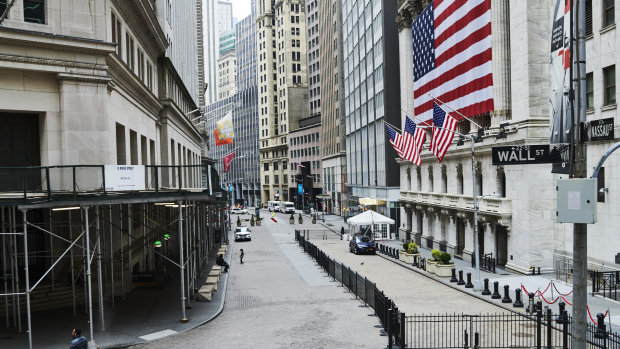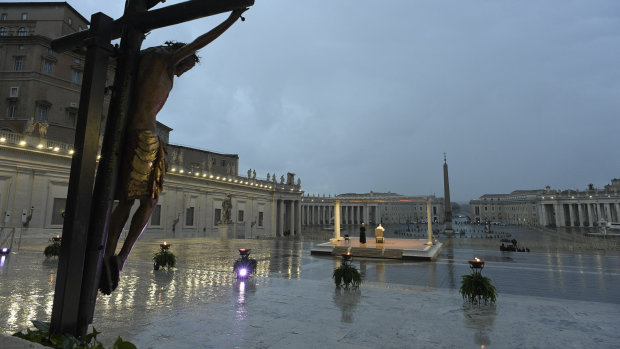Take a step back from the day to day gyrations of the market , and envision what you see in the year and years ahead.
There are two views- the Hibernation view as promulgated by our PM that we could bounce back after the virus dies off , and the other view (like Mish Shedlock/Jim Bianco/Rickards/Rogoff) is one that suggest that the World as we knew it would have changed and the world economy could be sicker for deeper and longer . The first view is based on the premise that this contagion is short lived and that we would not get a resumption of sorts and that everything central bankers and Governments have done is adequate to stall a more painful and severe recession, and that we have been through this before and we will get through it as we did with GFC. The half-glass full view and certainly one that we all must pray and hope for.
But what if normalcy as we knew it would not be the same anymore as the article below expresses? Yes, we would get through it eventually as we are constantly told but no one would tell you there would be many casualties (lives, jobs, businesses, investments) between now and then preferring not to dwell on the negatives. The danger with this view is one of hope , possibly denial (of the worse that could happen) and feeling of hopelessness leading to doing absolutely nothing.
Instead, its time to envision what lies ahead, just as I suggested to market participants back a month ago if they could envision a recession- the latter is now a foregone conclusion, the question remains how deep and how long and severe it could be. And if you believe it is going to be so (deep and prolonged) , then you would know what actions and steps you would need to undertake to protect yourself.
Being Ahead of the Curve is asking ourselves the hard questions that we must form a forward opinion before we come to know the answer. Call it calculated anticipation. We get that wrong sometimes but at least we act based on the convictions that we formulate. Most people would wait to be told a recession is on the way and then act, that is being behind the curve.
Why this global recession might be here a long time
The economic downturn may endure into 2021 and beyond as business restrictions tighten worldwide, putting paid to hopes of any quick, robust recovery.
Peter Goodman
Apr 2, 2020 – 10.54am
London | The world is almost certainly ensnared in a devastating recession delivered by the coronavirus pandemic.
Now, fears are growing that the downturn could be far more punishing and long lasting than initially feared — potentially enduring into next year, and even beyond — as governments intensify restrictions on business to halt the spread of the pandemic, and as fear of the virus reconfigures the very concept of public space, impeding consumer-led economic growth.
'This is already shaping up as the deepest dive on record for the global economy for over 100 years,' says Harvard economist Kenneth Rogoff. Bloomberg
The pandemic is above all a public health emergency. So long as human interaction remains dangerous, business cannot responsibly return to normal. And what was normal before may not be anymore. People may be less inclined to jam into crowded restaurants and concert halls even after the virus is contained.
The abrupt halt of commercial activity threatens to impose economic pain so profound and enduring in every region of the world at once that recovery could take years. The losses to companies, many already saturated with debt, risk triggering a financial crisis of cataclysmic proportions.
"I feel like the 2008 financial crisis was just a dry run for this," said Kenneth Rogoff, a Harvard economist and co-author of a history of financial crises, This Time Is Different: Eight Centuries of Financial Folly.
"This is already shaping up as the deepest dive on record for the global economy for over 100 years," he said. "Everything depends on how long it lasts, but if this goes on for a long time, it's certainly going to be the mother of all financial crises."
People have had a real shock
The situation looks uniquely dire in developing countries, which have seen investment rush for the exits this year, sending currencies plummeting, forcing people to pay more for imported food and fuel, and threatening governments with insolvency — all of this while the pandemic itself threatens to overwhelm inadequate medical systems.
St Peter's square looms empty in Rome as Italy and Spain have become the two hardest-hit European countries. AP
Among investors, a hopeful scenario holds currency: The recession will be painful but short-lived, giving way to a robust recovery this year. The global economy is in a temporary deep freeze, the logic goes. Once the virus is contained, enabling people to return to offices and shopping malls, life will snap back to normal. Jets will fill with families going on merely deferred vacations. Factories will resume, fulfilling saved up orders.
But even after the virus is tamed — and no one really knows when that will be — the world that emerges is likely to be choked with trouble, challenging the recovery. Mass joblessness exacts societal costs. Widespread bankruptcy could leave industry in a weakened state, depleted of investment and innovation.
Households may remain agitated and risk averse, making them prone to thrift. Some social distancing measures could remain indefinitely. Consumer spending amounts to roughly two-thirds of economic activity worldwide. If anxiety endures and people are reluctant to spend, expansion will be limited — especially as continued vigilance against the coronavirus may be required for years.
"The psychology won't just bounce back," said Charles Dumas, chief economist at TS Lombard, an investment research firm in London. "People have had a real shock. The recovery will be slow, and certain behaviour patterns are going to change, if not forever at least for a long while."
Rising stock prices in the US have in recent years propelled spending. Millions of people are now filing claims for unemployment benefits, while wealthier households are absorbing the reality of substantially diminished retirement savings.
Americans boosted their rates of savings significantly in the years after the Great Depression. Fear and tarnished credit limited reliance on borrowing. That could happen again.
Struggling to secure parts
"The loss of income on the labour front is tremendous," Dumas said. "The loss of value in the wealth effect is also very strong."
The United States, the world's largest economy, is almost certainly in a recession. So is Europe. So probably are significant economies like Canada, Japan, South Korea, Singapore, Brazil, Argentina and Mexico. China, the world's second-largest economy, is expected to grow by only 2 per cent this year, according to TS Lombard.
When the pandemic emerged, initially in central China, it was viewed as a substantial threat to that economy. Even as China closed itself off, conventional wisdom held that, at worst, large international companies like Apple and General Motors would suffer lost sales to Chinese consumers, while manufacturers elsewhere would struggle to secure parts made in Chinese factories.
But then the pandemic spread to Italy and eventually across Europe, threatening factories on the continent. Then came government policies that essentially locked down modern life, business included, while the virus spread to the United States.
"Now, anywhere you look in the global economy we are seeing a hit to domestic demand on top of those supply chain impacts," said Innes McFee, managing director of macro and investor services at Oxford Economics in London. "It's incredibly worrying."
Oxford Economics estimates that the global economy will contract marginally this year, before improving by June. But this view is likely to be revised down sharply, McFee said.
Mexico to South Korea
Trillions of dollars in credit and loan guarantees dispensed by central banks and governments in the United States and Europe have perhaps cushioned the most developed economies. That may prevent large numbers of businesses from failing, say economists, while ensuring that workers who lose jobs will be able to stay current on their bills.
"I am attached to the notion that this is a temporary crisis," said Marie Owens Thomsen, global chief economist at Indosuez Wealth Management in Geneva. "You hit the pause button, and then you hit the start button, and the machine starts running again."
Worldwide, foreign direct investment is on track to decline 40 per cent this year, according to the UN Conference on Trade and Development. This threatens "lasting damage to global production networks and supply chains," said the body's director of investment and enterprise, James Zhan.
"It will likely take two to three years for most economies to return to their pre-pandemic levels of output," IHS Markit said in a recent research note.
In developing countries, the consequences are already severe. Not only is capital fleeing, but a plunge in commodity prices — especially oil — is assailing many countries, among them Mexico, Chile and Nigeria. China's slowdown is rippling out to countries that supply Chinese factories with components, from Indonesia to South Korea.
Between now and the end of next year, developing countries are on the hook to repay some $US2.7 trillion ($4.4 trillion) in debt, according to a report released on Monday by the UN trade body. In normal times, they could afford to roll most of that debt into new loans. But the abrupt exodus of money has prompted investors to charge higher rates of interest for new loans.
The UN body called for a $US2.5 trillion rescue for developing countries — $US1 trillion in loans from the International Monetary Fund, another $US1 trillion in debt forgiveness from a broad range of creditors and $US500 billion for health recovery.
"The great fear we have for developing countries is that the economic shocks have actually hit most of them before the health shocks have really begin to hit," said Richard Kozul-Wright, director of the division on globalisation and development strategies at the UN trade body in Geneva.
In the most optimistic view, the fix is already underway. China has effectively contained the virus and is beginning to get back to work, though gradually.
If Chinese factories spring back to life, that will ripple out across the globe, generating demand for computer chips made in Taiwan, copper mined in Zambia and soybeans grown in Argentina.
But China's industry is not immune to global reality. Chinese consumers are an increasingly powerful force, yet cannot spur a full recovery. If Americans are still contending with the pandemic, if South Africa cannot borrow on world markets and if Europe is in recession, that will limit the appetite for Chinese wares.
"If Chinese manufacturing comes back, who exactly are they selling to?" asked Rogoff, the economist. "How can global growth not take a long-term hit?"
The New York Times
- Forums
- ASX - General
- Its Over
Take a step back from the day to day gyrations of the market ,...
- There are more pages in this discussion • 18,538 more messages in this thread...
You’re viewing a single post only. To view the entire thread just sign in or Join Now (FREE)






